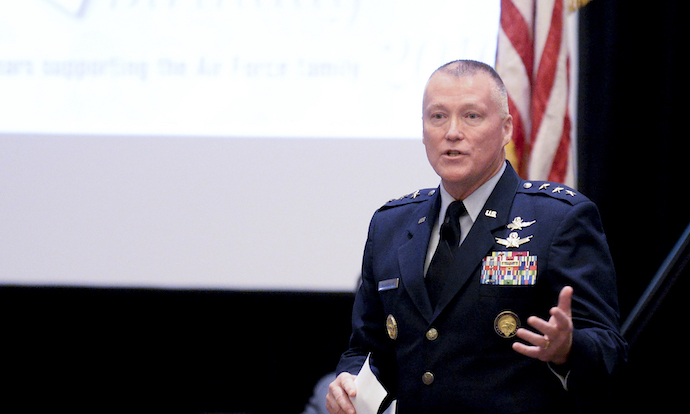
Conference name emphasizes importance of cyber domain to USAF and allied operations.
The Air Force Association's annual meeting has a name that emphasizes the importance of the cyber domain in Air Force strategic, operational, and tactical thinking.
Day 1
Discussions at the event stressed the necessity of buildin a unified "cross-domain" capability in which cyber operations were integrated with the more traditional air and space operations.
We have a report on Monday's panel discussion, "Warfighting in a Cyber-Contested Environment," and we'll follow this up later this week with coverage of other presentations and talks.
Oh, and if you missed the conference's featured announcement—a non-cyber related one—the Air Force has given a name to its next-generation long-range bomber, the Northrop-Grumman B-21. That name will be "Raider." (It will, of course, be developed with an appropriate cyber operations suite of capabilities.)
Day 2
Lieutenant General Kevin McLaughlin, Deputy Commander of US Cyber Command, opened the conference's second day with an overview of his organization and its mission. He stressed its responsibility for three missions: defense of Department of Defense information networks, support combatant commanders with "full spectrum" (that is, defensive and offensive) capabilities to joint forces, and (when directed by the National Command Authority) to protect US critical infrastructure against cyber attacks "of significant consequence."

Lt. Gen. Kevin McLaughlin, the U.S. Cyber Command deputy commander, discusses cyber warfare during the Air Force Association's Air, Space and Cyber Conference in National Harbor, Md., Sept. 20, 2016. U.S. Air Force photo/Scott M. Ash
Discussions at the conference have stressed the necessity of building a unified "cross-domain" capability in which cyber operations were integrated with the more traditional air and space operations.
Should you have missed the conference's featured announcement—a non-cyber related one—the Air Force has given a name to its next-generation long-range bomber, the Northrop-Grumman B-21. That name will be "Raider." (It will, of course, be developed with an appropriate cyber operations suite of capabilities.)
The conference was, as one attendee remarked, "heavy-industry heavy," with producers of aircraft, munitions, and avionics strongly represented on the conference floor (service organizations and providers dedicated to Air Force members and their families were second most in evidence). There were some cyber security providers in evidence, and not all were big integrators with cyber divisions. More to the point, a general awareness of, and concern for, the cyber security of advanced systems currently under development.
There was also evident concern for development of a cyber security workforce—primarily military, to be sure, but also civilian. The Air Force, like everyone else, understands that it's operating in a very tight labor market, and it's looking for as much flexibility ("agility," as the A-1, Lieutenant General Grosso, put it) in recruiting and retention as possible.
Two initiatives stand out. Everyone had very good things to say about Cyber Patriot, the Air Force Association-led youth cyber education program. And the Military Cyber Professional Association was also present on the floor, a group organized to support and foster the growth of the profession.
